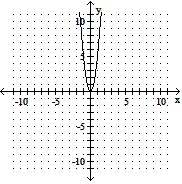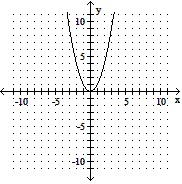Graph the equation by completing the table of values.y = 5x2

A. 

B. 

C. 

D. 

Answer: A
You might also like to view...
a = 3.9 cm, b = 1.2 cm, C = 90°Round values to one decimal place.
A. A = 17.1°, B = 72.9°, c = 4.1 cm B. A = 17.9°, B = 72.1°, c = 5.1 cm C. A = 68.4°, B = 21.6°, c = 4.1 cm D. A = 72.9°, B = 17.1°, c = 4.1 cm
Find the probability.If you are dealt two cards successively (without replacement) from a standard 52-card deck, find the probability of getting two black cards.
A. 
B. 
C. 
D. 
Solve the problem.In the formula A(t) = A0ekt, A is the amount of radioactive material remaining from an initial amount A0 at a given time t, and k is a negative constant determined by the nature of the material. An artifact is discovered at a certain site. If it has 59% of the carbon-14 it originally contained, what is the approximate age of the artifact? Carbon-14 decays at the rate of 0.0125% annually. Round to the nearest year, if necessary.
A. 4720 years B. 1833 years C. 3280 years D. 4221 years
Decide whether the equation is an identity, a conditional equation, or a contradiction. Give the solution set.4(16x + 20) = 16(2x - 13)
A. Contradiction; ? B. Identity; {all real numbers} C. Conditional; {-9} D. Conditional; {4}